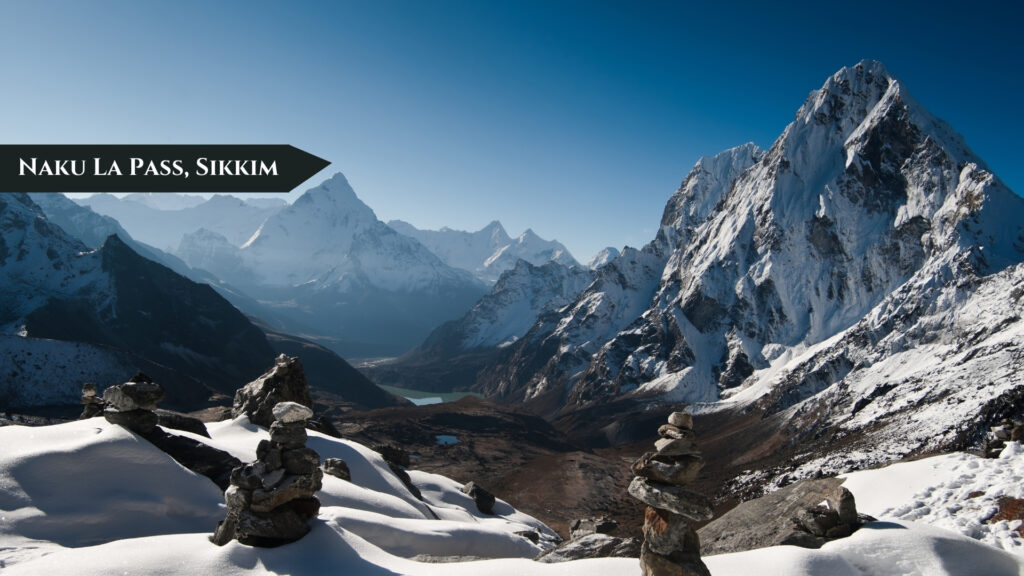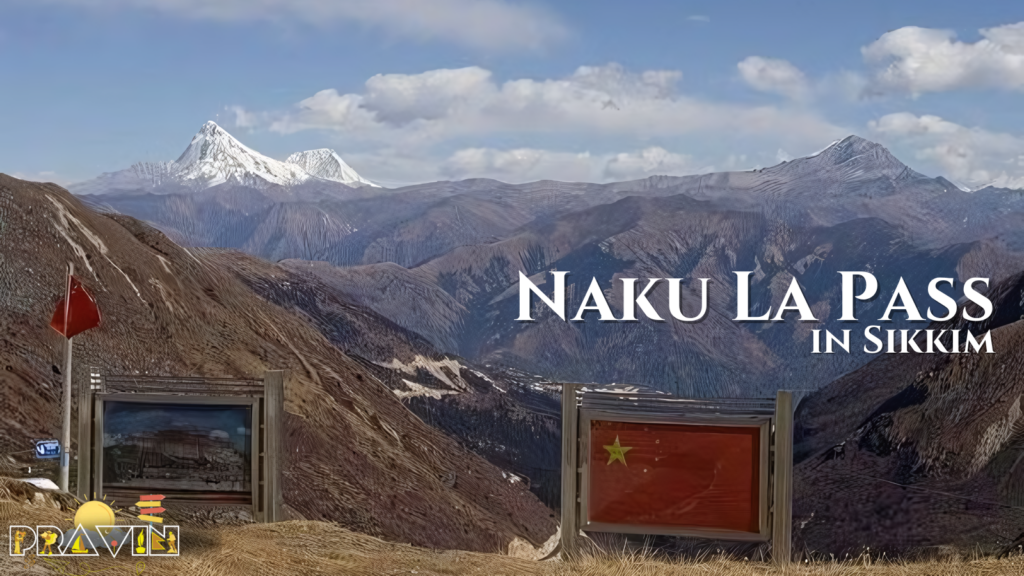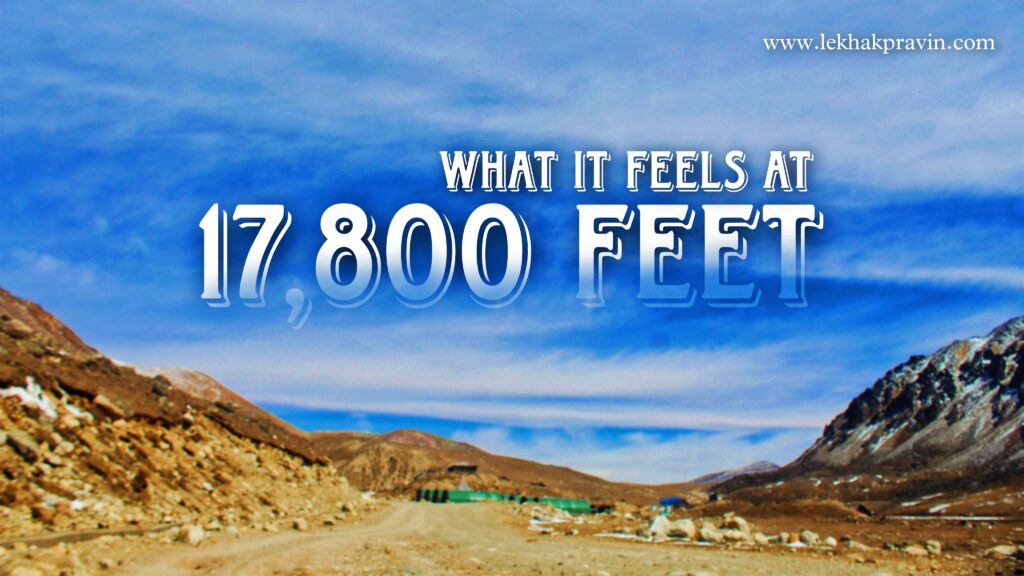Naku La Pass is a high mountain pass situated in the Indian state of Sikkim. The pass is situated in the majestic Himalayan mountain range. Naku La stands at an elevation of approximately 16,600 feet (5,060 meters), surrounded by amazing views of the surrounding peaks and valleys.
The pass is strategically significant due to its proximity to the India-China border and is an area of great geopolitical interest. Though the pass is not a typical trekking destination like Goecha La, Naku La draws attention for its stunning landscapes and strategic importance.
Significance of Naku La Pass
Naku La holds strategic military importance for India. It serves as a crucial point in maintaining surveillance and defense along the border with China. The Indian Army and Indo-Tibetan Border Police are stationed in the region to safeguard this high-altitude pass.

Culturally, the region around Naku La is steeped in local traditions and Tibetan Buddhist influences. The pass is adorned with prayer flags and cairns, representing the spiritual significance attributed by the local communities.
Naku La Pass Border Country
Naku La is located in northern Sikkim, close to the border with China’s Tibet Autonomous Region. The pass is a vital link in the border defense strategy of India, lying in a region characterized by rugged terrain and harsh climatic conditions.
The proximity of Naku La Pass to the border makes it a focal point for monitoring cross-border activities and ensuring national security. The pass has also been a site of occasional skirmishes and standoffs between Indian and Chinese troops, underscoring its strategic importance.
Naku La Pass War History
Naku La Pass has witnessed several border tensions and confrontations between India and China. In recent years, the pass gained prominence due to military standoffs and skirmishes, reflecting the broader strategic rivalry between the two nations.
In May 2020, a significant clash occurred at Naku La, resulting in injuries to soldiers on both sides. This incident highlighted the ongoing border disputes and the importance of maintaining a robust military presence in the region.
How to Reach Naku La Pass
Reaching Naku La Pass requires special permits due to its sensitive location near the India-China border. The nearest major town is Gangtok, the capital of Sikkim, which is well-connected by road to other parts of the state and neighboring regions.

From Gangtok, one can hire a vehicle to reach Lachen, a small town in North Sikkim. Lachen serves as the base for further travel to Naku La Pass. Due to the restricted nature of the area, it is essential to travel with a registered tour operator and obtain the necessary permits from the Sikkim Tourism Department.
Best Time to Visit Naku La Pass
The best time to visit Naku La Pass is during the summer months from April to June and autumn from September to November. During these periods, the weather is relatively stable, and the roads are accessible.
Winter months from December to February are extremely cold, with heavy snowfall making the pass inaccessible. The monsoon season from July to August brings heavy rains, which can lead to landslides and difficult travel conditions.
Naku La Pass Height
Naku La Pass is located at an altitude of 16,600 feet (5,060 meters) above sea level. This high altitude makes it a challenging destination to access and requires travelers to acclimatize properly to avoid altitude sickness.
The journey to Naku La involves traversing steep mountain roads and dealing with rapidly changing weather conditions, making it an adventurous yet demanding trip.
Naku La Pass height in feet is 16,600 feet.
Height of Nakula Pass in meters is 5,060 meters.
My Experience of Naku La Pass
Visiting Naku La Pass was an exhilarating experience, marked by breathtaking views and a palpable sense of history and strategic importance. The journey from Gangtok to Lachen was scenic, with lush valleys and towering peaks.
The drive to Naku La itself was thrilling, with winding roads and dramatic landscapes. Upon reaching the pass, the sight of the snow-clad mountains and the stark beauty of the high-altitude terrain was awe-inspiring.
The presence of the Indian Army personnel and their warm hospitality added a unique dimension to the visit. It was a stark reminder of the sacrifices made by the soldiers to protect the nation in such harsh and remote conditions.
Things to Keep in Mind While Visiting Naku La Pass
- Permits: Ensure you obtain the necessary permits from the Sikkim Tourism Department through a registered tour operator.
- Acclimatization: Proper acclimatization is crucial due to the high altitude. Ascend gradually and stay hydrated to avoid altitude sickness.
- Weather: Be prepared for rapidly changing weather conditions. Carry layered clothing, good quality trekking shoes, and rain/snow protection.
- Respect Local Customs: Respect the local culture and traditions. Do not litter, avoid making noise, and be mindful of the spiritual significance of the area.
- Travel Arrangements: Due to its sensitive location, travel arrangements should be made well in advance through a reliable tour operator.
History of Naku La Pass
Naku La has been a crucial point in the historical border dynamics between India and China. While not as well-documented as other mountain passes, its strategic importance has made it a focal point in the broader context of Indo-China relations.
The pass gained significant attention during the 2020 border skirmishes, bringing it into the spotlight and highlighting the ongoing territorial disputes in the region. The historical and geopolitical significance of Naku La Pass continues to shape its role in India’s defense strategy.
Conclusion
Naku La Pass stands as a testament to the rugged beauty and strategic importance of the Himalayan region in Sikkim. With its stunning landscapes, challenging terrain, and geopolitical significance, it offers a unique experience for those adventurous enough to visit.
If you seek to explore a high-altitude pass with a blend of natural beauty and strategic importance, Naku La is worth the journey. Prepare well, respect the environment, and immerse yourself in the extraordinary adventure.
FAQs Related to Naku La Pass
1. What is the best time to visit Naku La Pass?
The best time to visit Naku La is during the summer (April to June) and autumn (September to November) seasons when the weather is relatively stable.
2. How difficult is the journey to Naku La Pass?
The journey to Naku La is challenging due to the high altitude and rugged terrain. Proper acclimatization and physical fitness are essential.
3. What is the highest altitude reached at Naku La Pass?
The highest point at Naku La is approximately 16,600 feet (5,060 meters) above sea level.
4. What permits are required to visit Naku La Pass?
Special permits are required to visit Naku La due to its proximity to the India-China border. These can be obtained through a registered tour operator.
5. What kind of accommodation is available near Naku La Pass?
Accommodation is available in Lachen, the base town for visiting Naku La. Options include guesthouses and lodges.
6. Is there mobile connectivity at Naku La Pass?
Mobile connectivity is limited and intermittent at Naku La. The last point with reliable connectivity is Lachen.
7. What is the level of fitness required for visiting Naku La Pass?
Visiting Naku La Pass requires good cardiovascular endurance and acclimatization. Prior experience with high-altitude travel is recommended.
8. What equipment and gear are needed for visiting Naku La Pass?
Essential gear includes warm and waterproof clothing, sturdy trekking shoes, and basic supplies for high-altitude travel.
9. Are there any risks of altitude sickness at Naku La?
Yes, there is a risk of altitude sickness due to the high altitude. Symptoms include headache, nausea, and dizziness. Proper acclimatization is crucial.
10. What are the strategic and geopolitical significance of Naku La Pass?
Naku La is strategically significant due to its location near the India-China border, making it a crucial point for national defense and surveillance.




